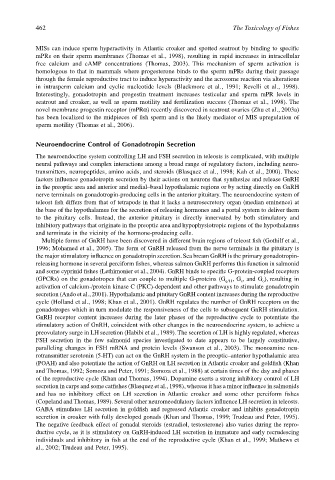Page 482 - The Toxicology of Fishes
P. 482
462 The Toxicology of Fishes
MISs can induce sperm hyperactivity in Atlantic croaker and spotted seatrout by binding to specific
mPRs on their sperm membranes (Thomas et al., 1998), resulting in rapid increases in intracellular
free calcium and cAMP concentrations (Thomas, 2003). This mechanism of sperm activation is
homologous to that in mammals where progesterone binds to the sperm mPRs during their passage
through the female reproductive tract to induce hyperactivity and the acrosome reaction via alterations
in intrasperm calcium and cyclic nucleotide levels (Blackmore et al., 1991; Revelli et al., 1998).
Interestingly, gonadotropin and progestin treatment increases testicular and sperm mPR levels in
seatrout and croaker, as well as sperm motility and fertilization success (Thomas et al., 1998). The
novel membrane progestin receptor (mPRα) recently discovered in seatrout ovaries (Zhu et al., 2003a)
has been localized to the midpieces of fish sperm and is the likely mediator of MIS upregulation of
sperm motility (Thomas et al., 2006).
Neuroendocrine Control of Gonadotropin Secretion
The neuroendocrine system controlling LH and FSH secretion in teleosts is complicated, with multiple
neural pathways and complex interactions among a broad range of regulatory factors, including neuro-
transmitters, neuropeptides, amino acids, and steroids (Blasquez et al., 1998; Kah et al., 2000). These
factors influence gonadotropin secretion by their actions on neurons that synthesize and release GnRH
in the preoptic area and anterior and medial–basal hypothalamic regions or by acting directly on GnRH
nerve terminals on gonadotropin-producing cells in the anterior pituitary. The neuroendocrine system of
teleost fish differs from that of tetrapods in that it lacks a neurosecretory organ (median eminence) at
the base of the hypothalamus for the secretion of releasing hormones and a portal system to deliver them
to the pituitary cells. Instead, the anterior pituitary is directly innervated by both stimulatory and
inhibitory pathways that originate in the preoptic area and hypophysiotropic regions of the hypothalamus
and terminate in the vicinity of the hormone-producing cells.
Multiple forms of GnRH have been discovered in different brain regions of teleost fish (Gothilf et al.,
1996; Mohamed et al., 2005). The form of GnRH released from the nerve terminals in the pituitary is
the major stimulatory influence on gonadotropin secretion. Sea bream GnRH is the primary gonadotropin-
releasing hormone in several perciform fishes, whereas salmon GnRH performs this function in salmonid
and some cyprinid fishes (Lethimonier et al., 2004). GnRH binds to specific G-protein-coupled receptors
(GPCRs) on the gonadotropes that can couple to multiple G-proteins (G q/11 , G , and G ), resulting in
o
s
activation of calcium-/protein kinase C (PKC)-dependent and other pathways to stimulate gonadotropin
secretion (Ando et al., 2001). Hypothalamic and pituitary GnRH content increases during the reproductive
cycle (Holland et al., 1998; Khan et al., 2001). GnRH regulates the number of GnRH receptors on the
gonadotropes which in turn modulate the responsiveness of the cells to subsequent GnRH stimulation.
GnRH receptor content increases during the later phases of the reproductive cycle to potentiate the
stimulatory action of GnRH, coincident with other changes in the neuroendocrine system, to achieve a
preovulatory surge in LH secretion (Habibi et al., 1989). The secretion of LH is highly regulated, whereas
FSH secretion in the few salmonid species investigated to date appears to be largely constitutive,
paralleling changes in FSH mRNA and protein levels (Swanson et al., 2003). The monoamine neu-
rotransmitter serotonin (5-HT) can act on the GnRH system in the preoptic–anterior hypothalamic area
(POAH) and also potentiate the action of GnRH on LH secretion in Atlantic croaker and goldfish (Khan
and Thomas, 1992; Somoza and Peter, 1991; Somoza et al., 1988) at certain times of the day and phases
of the reproductive cycle (Khan and Thomas, 1994). Dopamine exerts a strong inhibitory control of LH
secretion in carps and some catfishes (Blasquez et al., 1998), whereas it has a minor influence in salmonids
and has no inhibitory effect on LH secretion in Atlantic croaker and some other perciform fishes
(Copeland and Thomas, 1989). Several other neuromeodulatory factors influence LH secretion in teleosts.
GABA stimulates LH secretion in goldfish and regressed Atlantic croaker and inhibits gonadotropin
secretion in croaker with fully developed gonads (Khan and Thomas, 1999; Trudeau and Peter, 1995).
The negative feedback effect of gonadal steroids (estradiol, testosterone) also varies during the repro-
ductive cycle, as it is stimulatory on GnRH-induced LH secretion in immature and early recrudescing
individuals and inhibitory in fish at the end of the reproductive cycle (Khan et al., 1999; Mathews et
al., 2002; Trudeau and Peter, 1995).

